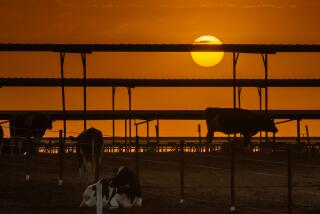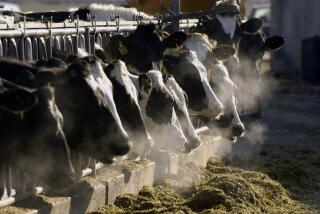Cattle and Grain Futures Tumble
- Share via
Cattle and grain futures took a beating Wednesday on news of the first recorded U.S. case of “mad cow” disease.
An outbreak of the brain-wasting disease could cripple the $175-billion U.S. beef industry, just as it did in Britain in the 1990s and this year in Canada. Japan, the largest customer for U.S. beef, South Korea and Mexico banned U.S. imports after Tuesday’s announcement.
“We’ve certainly lost our export market for beef,” said Troy Vetterkind, an analyst at E- Hedger in Chicago. “That’s going to be quite a blow. Domestic demand is going to take a hit, but people aren’t going to quit eating beef.”
Cattle for February delivery fell 1.5 cents, or 1.7%, to 89.175 cents a pound in light trading on the Chicago Mercantile Exchange, which closed early and will remain closed today for the Christmas holiday. A one-day move of 1.5 cents up or down is the most allowed under current price conditions at the exchange.
Cattle futures had gained 25% since the U.S. banned Canadian cattle May 20 after a case of “mad cow” disease, known as bovine spongiform encephalopathy, was confirmed in Alberta.
The U.S. was set in 2003 to have a record year of beef exports, $3.6 billion, up from $3.2 billion last year, said Gregg Doud, chief economist for the National Cattlemen’s Beef Assn. The U.S. Department of Agriculture estimated total beef and veal exports for last year at just under 2.5 billion pounds, or about 9% of U.S. production.
The loss of exports isn’t the only concern for cattle producers. Shares of U.S. restaurant companies -- especially hamburger and steakhouse chains -- tumbled Wednesday on worries that diners will shun beef.
Meanwhile, corn futures fell to a six-week low on concern that demand for beef raised on grain-based animal feed will drop. Ranchers may keep cattle in pasture longer before selling animals to feedlots, while they wait for cattle futures to stabilize, analysts said, reducing the need for livestock feed. About 70% of the U.S. corn crop is used in animal feed.
“There is a race to the exit,” James Brooks, a manager at R.J. O’Brien, a Chicago-based futures brokerage, said from the floor of the Chicago Merc. Not only will there be less demand for beef, but there also will be less demand for grain as ranchers hold on to young cattle longer “so hopefully all this will get behind them.”
Corn for March delivery fell 8 cents, or 3.3%, to $2.3575 a bushel on the Chicago Board of Trade, the lowest closing price for a most-active contract since Nov. 11. Corn had gained 3.4% this year because of strong export sales.
Ranchers typically sell young cattle to feedlots when they are about 1 year old and weigh about 750 pounds. The feedlots then fatten the animals on a corn-rich diet for about four months until they weigh about 1,200 pounds and are sold to slaughtering plants.
More to Read
Inside the business of entertainment
The Wide Shot brings you news, analysis and insights on everything from streaming wars to production — and what it all means for the future.
You may occasionally receive promotional content from the Los Angeles Times.










